News
Battlefield Tour 2018
31st October 2018
On the 5th of October, the two buses carrying Military Preparation College Learners from Cardiff, Newport, Swansea, Bridgend, Merthyr-Tydfil, Bangor, Wrexham and Liverpool departed early-morning for Folkstone to board the Eurotunnel. On arrival in Calais in the late afternoon, MPCT Staff ensured a swift check-in to the Poppies Hotel Albert from which the party departed for dinner.
Learners and Staff departed by 8 a.m. on the 5th of October for the first stop, Mametz Wood and Sheffield Memorial Park. Learners were split into two groups and their itineraries arranged accordingly ensuring that all Learners would see all sites.
Mametz Wood provided the Learners with rich military historical knowledge, and features a Welsh Dragon statue commemorating an engagement of the 38th Welsh Division of the British Army during the First Battle of the Somme in France in 1916 (Pictured). 3993 welsh soldiers were killed, missing or injured. The Sheffield Memorial Park educated Learners the men of the British Army’s 31st Division who served with the Pals Battalions also in The Somme. Of the 12 battalions in the 31st Division, all but two were recruited from Yorkshire, one of these being from Durham and the other from Lancashire.
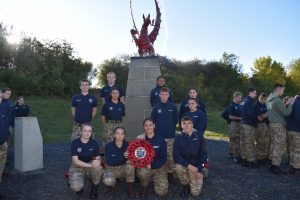
Group One Learners then carried on their morning themed by the Battle of the Somme to the Devonshire Trench; a small Commonwealth War Graves Commission burial site for some of the British Empire and Commonwealth troops killed during the battle. Group Two then visited Newfoundland Park in Beaumont-Hamel, a piece of land purchased by the Dominion of Newfoundland after the First World War. It was named after the Royal Newfoundland Regiment, which had provided one battalion of 800 men to serve with the British and Commonwealth Armies. Three bronze plaques are at the base of the bronze caribou memorial, commemorating the 820 men the gave their lives and whose bodies have never been found. At this location the Learners also got to see the “Y Ravine” cemetery made by the British V corps in the spring of 1917 where there are now over 400 war casualties commemorated at this site, of which a third are unidentified. At the entrance of the memorial park, the Learners got to witness the “Danger Tree” as it was the only one to survive the devastation. Needless to say, all of these significant sites were poignant moments for the Learners, and this was only half way through the first day of the tour.
The Second half of day one saw the Group 1 Learners arrive in Fricourt where the stark contrast of a German Memorial was seen due to the plain and dark crosses instead of the more grand scenes at the British memorials just witnessed. Also near to this memorial was the Lochnager Crater in La Boiselle which was created by a large mine placed beneath the German front lines on the first day of the Battle of the Somme, it was one of 19 mines that were placed beneath the German lines from the British section of the Somme front, to assist the infantry advance at the start of the battle. The sheer size and significance of its making had a clear impact on the Learners as they stood before the crater, reflecting on would it would have been like to be in the mine.
The Learners in group 2 at this time then visited Ulster Tower in Thiepval which commemorates the Ulster Battalions who fought there in 1916. One of the highlights of the trip, was the Thiepval Memorial (pictured below). Learners got to lay a wreath on the Memorial and view the 73,00 names on the walls of British and South African forces who died in the Somme sector before 20 March 1918 and have no known grave, the majority of whom died during the Somme offensive of 1916. Towering over 45 metres in height, it dominates the landscape for miles around. It is the largest Commonwealth memorial to the missing in the world.
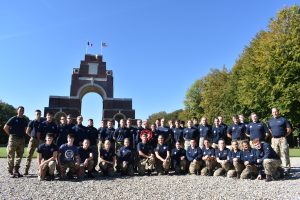
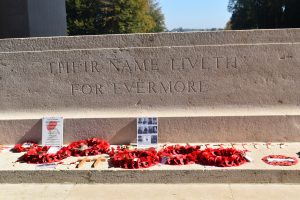
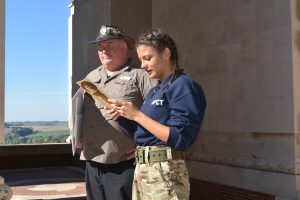
The late afternoon of the first day saw a visit to Sunken Road. The sunken road which was chosen as the forming up point, the British would attack from here following a huge artillery barrage and a massive mine being detonated at the Hawthorn redoubt. The setting off of the mine had the unfortunate side effect of alerting the Germans to the opposition formed up in the sunken road and they were subjected to a tremendous cross fire from the front and both sides. Snipers were killing the wounded and those who tried to help them,the road became blocked with dead and dying. the attack was costly; 7 officers killed and 14 wounded, 156 Other ranks killed and 298 wounded with 11 missing presumed dead. We won 4 military Crosses and 8 Military medals in that one day.
Awaking on the 6th of October bright and early, Learners were in Arras to see the Arras memorial by 9am. The memorial commemorates nearly 35,000 soldiers of the British, South African and New Zealand forces with no known grave. Most of those commemorated were killed in the Battle of Arras, fought between 9 April and 16 May 1917. The journey then moved onto Wellington Quarry, where the Battle of Arras and the stories of the New Zealand tunnelers were shown via an underground tour of the tunnels (Pictured).
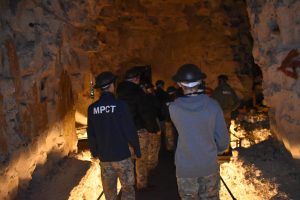
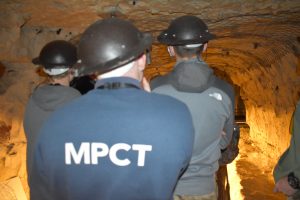
The last stop before heading to Belgium in the afternoon was the infamous Vimy Ridge. The Battle of Vimy Ridge proved to be a great success, but it only came at a heavy cost. The some 100,000 Canadians who served there suffered more than 10,600 casualties, nearly 3,600 of which were fatal. By the end of the First World War, Canada, a country of less than eight million people, would see more than 650,000 men and women serve in uniform. The conflict took a huge toll with more than 66,000 Canadians losing their lives and over 170,000 being wounded. The memorial built for this caused arguably provided the photo of the Battlefield Tour (pictured), which was greatly helped by the stunning blue sky behind.
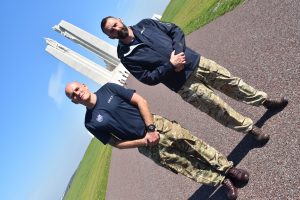
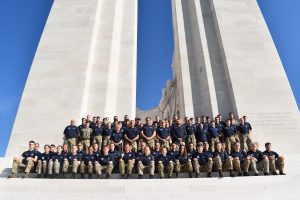
After the journey to Belgium, MPCT Learners and Staff arrived in Belgium mid afternoon on the 6th of October. First stop was Menin Gate, Ypres. Between October 1914 and September 1918 hundreds of thousands of servicemen of the British Empire marched through the town of Ypres’ Menin Gate on their way to the battlefields. The memorial now stands as a reminder of those who died who have no known grave and is perhaps one of the most well-know memorials in the world.

Learners also visited Hooge Crater and its museum. In the summer of 1915, charge of 1,700 kilograms of explosives were detonated in a tunnel that had been driven by the special Tunnelling Companies of the Royal Engineers. Immediately after the explosion the allies rushed to the crater in order to consolidate their advance. Later it was referred to as ‘the Hooge Crater’.
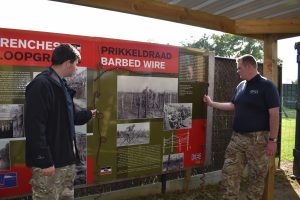
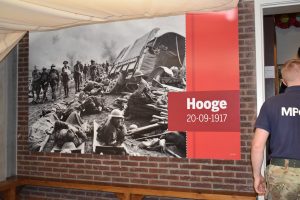
The last event of the day was to witness the daily Last Post Ceremony that occurs every night in Ypres town. Selected Learners laid wreaths at the ceremony which was attended by many servicemen and women. This was a time for reflection and remembrance for the Learners who seemed visibly moved by the event.


On the final day, Learner’s itineraries were filled with visits to Vancouver Corner, Hill 60, German Cemetery Langemark and Tyne Cot. Tyne cot was a barn named by the Northumberland Fusiliers which stood near the level crossing on the road from Passchendale to Broodseinde. The Tyne cot Memorial is one of four memorials dedicated to the missing in Belgian Flanders which cover the area known as the Ypres Salient.
Hill 60 was heavily shelled and mined by both sides, the ground forming said hill is 60 meters above sea-level, and today still remains the final resting place for countless soldiers buried somewhere beneath its grassy foundations. Vancouver corner is a memorial built in honour of the some 2000 fallen soldiers who fought around the location. Lastly, the vastly simple graves at the German Cemetary In Langemark evolved from a small group of graves from 1915, has seen numerous changes and extensions. Today, visitors find a mass grave near the entrance, this comrades’ grave contains 24,917 servicemen. Between the oak trees, next to this mass grave, are another 10,143 soldiers (including 2 British soldiers killed in 1918). The 3,000 school students who were killed during the First Battle of Ypres are buried in a third part of the cemetery. At the front of the cemetery is a sculpture of four mourning figures by Professor Emil Krieger. The sculpture was added in 1956, and is said to stand guard over the fallen. Adolf Hitler visited the cemetery on 1 June 1940 during a two-day tour of the Ypres front where he had served in WW1.
It is clear to see how enriching the Battlefield Tours are, and many letters of thanks to the Staff and The Motivation & Learning Trust have been received since.
The biggest lesson of all for me was the sacrifices made by all the men and women of the commonwealth, the reason we won the war is because the Commonwealth stood strong and fought hard, and this made me feel patriotic and proud to be going into the military.
Learner White, MPC Liverpool
Staff Evans of MPC Birmingham added;
The trip fulfilled every thing I could of wished for and I have to say that our tour guide Allan Wood AKA ‘Chippy’ was so interesting and his knowledge of WW1, the events, background and history was outstanding.
The trip had many highlights for me visiting Mametz Woods, Welsh Memorial grounds, the memorials at Arras, Ypres and the Somme, but when we stepped off the bus and the sun was shining on Vimy Ridge was absolutely breath taking and having the opportunity to visit this magnificent monument with the learners will stay with me forever.
Menin Gate Memorial on the Saturday evening was very humbling. For our learners to be part of this ‘Last Post Ceremony’ in front of 2,000 people was very touching.